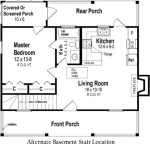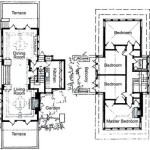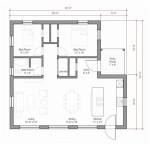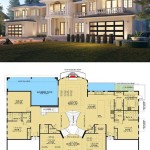Designing Your Own House Plans: Exploring Free Resources and Essential Considerations
The prospect of creating a personalized living space is an appealing endeavor for many. Designing one's own house plans offers the opportunity to tailor the structure to specific needs, preferences, and lifestyle requirements. While professional architectural services provide comprehensive expertise, exploring free resources for drafting initial house plans can be a valuable starting point. This article explores readily available tools and outlines essential considerations for individuals embarking on the journey of designing their own house plans without incurring initial costs.
It is crucial to acknowledge that "free" resources often come with limitations. Functionality may be curtailed, professional support might be absent, or the generated plans may lack the detailed specifications necessary for construction. However, these resources can be instrumental in conceptualizing the desired layout and understanding fundamental architectural principles before engaging professional services to finalize designs and ensure compliance with building codes.
Leveraging Online Platforms for Initial Design Concepts
The internet offers a plethora of online platforms claiming to facilitate free house plan design. These platforms vary significantly in their capabilities, user-friendliness, and output quality. Some platforms operate on a drag-and-drop interface, enabling users to arrange pre-designed elements to create a basic floor plan. Others offer more sophisticated tools allowing for customization of wall dimensions, door and window placement, and even basic 3D modeling. The effectiveness of these platforms hinges on the user's familiarity with design software and their understanding of spatial relationships.
One category of free resources includes basic floor plan creators. Typically, these are browser-based applications that allow users to draw walls, add doors and windows, and insert furniture elements. The primary advantage is their ease of use, making them accessible to individuals with limited technical skills. However, these platforms often lack the precision and detail required for accurate construction documents. They are best suited for generating rudimentary sketches and experimenting with different layout possibilities.
Another type of free platform provides access to a library of pre-designed house plans that can be customized to varying degrees. Users can browse these plans based on size, style, and number of bedrooms and bathrooms. The customization options may include altering wall colors, adding decks or patios, and rearranging interior spaces. While seemingly convenient, it is important to be cautious when modifying pre-existing plans. Structural integrity and adherence to local building codes must be meticulously assessed by a qualified professional before construction commences. Modifying a plan without proper expertise can lead to serious safety hazards and costly remediation efforts.
When utilizing online platforms, it is advisable to prioritize those offering features such as measurement tools, grid systems, and layering capabilities. These features enhance the accuracy and clarity of the generated plans. Furthermore, it is beneficial to select platforms that provide export options in standard file formats such as PDF or DWG (AutoCAD drawing file). This enables easy sharing and collaboration with contractors, engineers, and architects.
Understanding Building Codes and Regulations
Designing a house plan extends beyond aesthetics and personal preferences. Strict adherence to local building codes and regulations is paramount. These codes govern various aspects of construction, including structural integrity, fire safety, energy efficiency, and accessibility. Failure to comply with these regulations can result in significant delays, fines, and even the rejection of construction permits. Understanding the relevant building codes is an essential prerequisite to designing a house plan, even when using free resources for initial conceptualization.
Building codes vary significantly between jurisdictions, reflecting local climate conditions, geological characteristics, and historical building practices. Therefore, it is crucial to consult the specific building codes applicable to the intended location of the house. These codes are typically available online through the local municipality or building department. Familiarizing oneself with these regulations upfront can significantly streamline the design process and prevent costly revisions later on.
Key areas addressed by building codes include foundation requirements, framing specifications, electrical wiring standards, plumbing regulations, and ventilation requirements. The codes also dictate minimum room sizes, ceiling heights, and egress pathways. Furthermore, they often mandate the use of specific materials and construction techniques to enhance durability and resistance to natural hazards such as earthquakes, hurricanes, and floods.
Navigating building codes can be a complex and daunting task. It is highly recommended to consult with a building inspector or a qualified architect to ensure full compliance. While free resources can assist in creating initial house plans, they cannot substitute the expertise required to interpret and apply building codes accurately.
Accessibility considerations are also of utmost importance. The Americans with Disabilities Act (ADA) sets forth guidelines for making buildings accessible to individuals with disabilities. These guidelines address issues such as ramp slopes, doorway widths, and bathroom layouts. Incorporating accessibility features into the house plan is not only ethical but also legally mandated in many jurisdictions.
Assessing Site Conditions and Environmental Factors
The topography of the building site, soil composition, and prevailing climate conditions significantly influence the design of a house. A thorough site assessment is crucial to identify potential challenges and opportunities. Ignoring these factors can lead to structural problems, drainage issues, and energy inefficiencies. While free house plan resources focus primarily on the building design itself, it is essential to consider the interplay between the structure and its environment.
The slope of the land dictates the type of foundation required. A steeply sloping site may necessitate a stepped foundation or retaining walls to ensure stability. Soil composition affects the load-bearing capacity of the ground. Soft or unstable soils may require soil stabilization techniques or the use of piles to support the foundation. A geotechnical survey conducted by a qualified engineer can provide detailed information about soil conditions. This survey typically involves drilling boreholes and analyzing soil samples to determine the soil's strength, permeability, and potential for settlement.
Climate conditions such as rainfall, wind direction, and solar orientation influence the design of the roof, windows, and insulation. In areas with heavy rainfall, a steep roof pitch is recommended to facilitate water runoff. Strategic placement of windows can maximize natural light while minimizing heat gain during the summer months. Proper insulation reduces energy consumption and enhances thermal comfort. Passive solar design principles, such as orienting the house to maximize southern exposure, can significantly reduce heating and cooling costs.
Environmental factors such as groundwater levels and proximity to wetlands also influence the design. High groundwater levels can necessitate a waterproof foundation or a drainage system to prevent water intrusion. Building near wetlands may require special permits and mitigation measures to protect the sensitive ecosystem. It is prudent to consult with local environmental authorities to ascertain any restrictions or regulations applicable to the building site.
Furthermore, consider the existing vegetation on the site. Mature trees not only enhance the aesthetic appeal but also provide shade and reduce erosion. Preserving existing trees can significantly reduce landscaping costs and contribute to a more sustainable design. However, it is essential to ensure that tree roots do not interfere with the foundation or underground utilities.
In conclusion, while free resources can aid in the initial design phase, professional guidance is indispensable for ensuring structural integrity, compliance with building codes, and optimization of site conditions. Treat free resources as tools for exploration and conceptualization, rather than complete solutions for house plan design.

Create Floor Plan

Design Your Own House Floor Plans Must See This Acha Homes

Floor Plan Creator And Designer Free Easy App

Floor Plan Creator Planner 5d

House Plans How To Design Your Home Plan

Floor Plan Creator Planner 5d

3d Home Design Architect For Your Own House Free Planner Homify

Create Your Own Floor Plans House Design Interior Plan Programs

Impressive Make Your Own House Plans 1 Design Floor Free Home Plan

12 Examples Of Floor Plans With Dimensions








